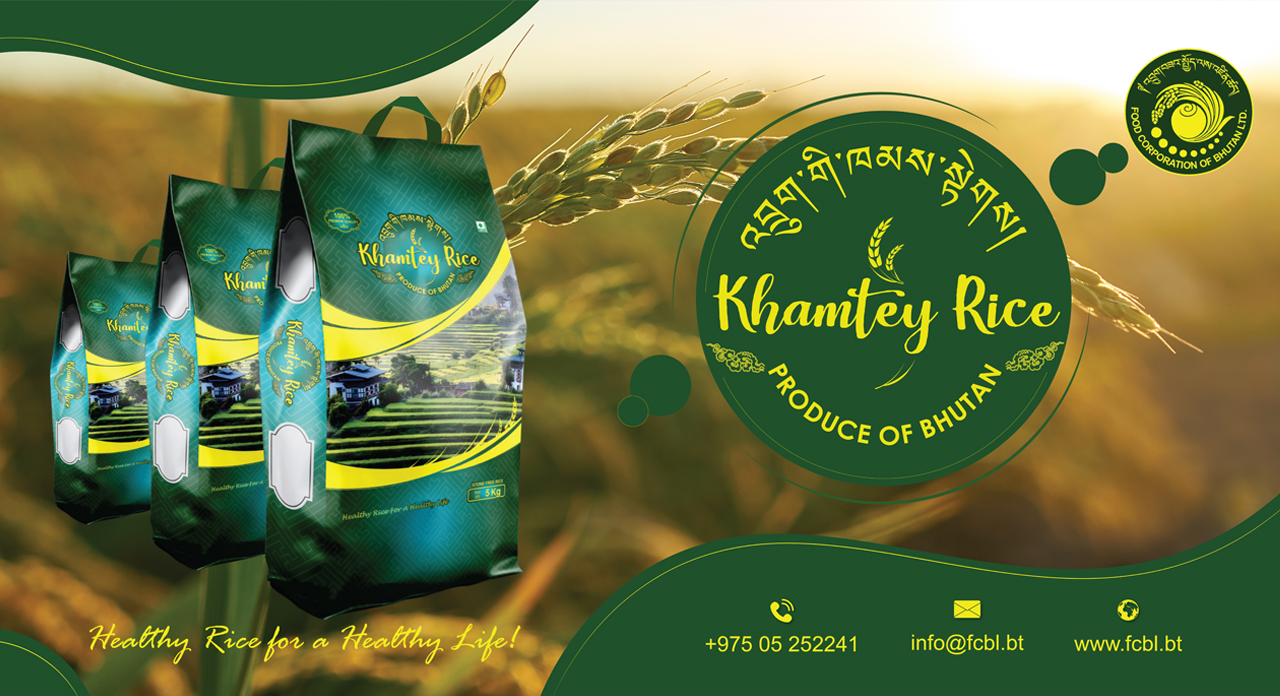Growing Popularity of Khamtey Rice: Insights and Challenges

.... the expected production of Khamtey rice is around 600 MT (paddy) from Chuzaygang in Sarpang and Samdrup Choling in SamdrupJongkhar. The launch of Khamtey rice as a brand (DrukGi Khamtey) by the Food Corporation of Bhutan (FCB) has garnered significant attention nationwide. Originating from Samdrup Choling Drungkhag under Samdrup Jongkhar, the aromatic Khamtey rice has seen a surge in popularity across Bhutan. Known for its unique taste and aroma, Khamtey rice has become a household name. The branding efforts by FCB have played a crucial role in boosting its recognition and demand. Khamtey rice has deep roots in Bhutanese culture and agriculture. Traditionally cultivated by generations of farmers in the fertile valleys of SamdrupCholing Drungkhag, this rice variety has long been cherished for its fragrant aroma and unique taste. Over time, Khamtey rice has become a symbol of Bhutan's rich agricultural heritage. The traditional farming methods passed down through generations are a testament to the dedication and expertise of Bhutanese farmers. While SamdrupCholing Drungkhag remains the primary source, questions arise regarding the cultivation of Khamtey rice in other parts of Bhutan, such as Punakha and Sarpang. When asked if Khamtey rice is harvested in regions like Gelephu and Punakha, an official from MoAL clarified, "We indeed get Khamtey from other parts of our country, but the taste and visual appearance of the grains differ due to variations in altitude, climate conditions, soil type, and other factors." These factors contribute to the distinct characteristics of Khamtey rice grown in different regions, making the Samdrup Choling variety particularly prized. Despite the current focus on Samdrup Choling Drungkhag, there are considerations to encourage Khamtey rice cultivation in other regions. Expanding the cultivation area can help meet the growing demand and provide more farmers with the opportunity to benefit from this lucrative crop. Khamtey rice production faces several challenges, particularly in Samdrup Choling Drungkhag. The primary issues include labor shortages, low yield compared to other rice varieties, wildlife conflicts, high costs of hiring machinery, and irrigation problems. Addressing these challenges is crucial for sustaining and increasing Khamtey rice production. Local farmers have firsthand experience with the challenges and rewards of cultivating Khamtey rice. Tendi, a farmer from Pemathang Gewog, said, "The demand for Khamtey rice has definitely increased, which is good for us. However, we struggle with labor shortages, especially during the planting and harvesting seasons. Hiring machinery for planting and harvesting is expensive. Many of us can't afford it, so we rely on manual labor, which is not always available." Samten Wangchuk, another farmer from Samdrup Choling, highlighted the issue of wildlife conflicts: "Wild animals often destroy our crops. It's a big problem that affects our yield and income. We've tried various methods to deter them, but the problem persists." Pema Lhamo, shared her concerns about irrigation: "Irrigation is a major issue for us. During the dry season, we struggle to provide enough water for our crops, which affects the yield." The Ministry of Agriculture and Livestock (MoAL) is actively working to mitigate these challenges. The Ministry is focused on providing support to farmers in terms of subsidies for machinery, better irrigation facilities, and measures to protect crops from wildlife. An official from MoAL stated, "We are committed to supporting our farmers by providing necessary resources and training to improve their yield and reduce production costs." Local communities play a vital role in the production and promotion of Khamtey rice. The involvement of these communities not only ensures the authenticity of the product but also brings significant benefits to the farmers. By participating in the cultivation and marketing processes, farmers gain access to a steady income, better market opportunities, and improved living standards. Ongoing research and development (R&D) projects are also aimed at improving Khamtey rice production. These projects focus on developing high-yield varieties, improving pest and disease resistance, and optimizing cultivation techniques. Such initiatives are essential for enhancing the productivity and sustainability of Khamtey rice farming. Starting this season, the mandate of the Farm Machinery Corporation Limited (FMCL) has been revised to aggressively play an aggregation role for six priority crops: rice, wheat, maize, quinoa, peanuts, and soybeans. An official from FMCL explained, "Our goal is to begin purchasing 500 MT of Khamtey paddy from farmers, process it, and supply it to FCBL this year. This initiative will provide farmers with an assured market and encourage others to revive their fallow land and grow Khamtey." The expected production of Khamtey rice is around 600 MT (paddy) from Chuzaygang in Sarpang and Samdrup Choling in SamdrupJongkhar. This production target reflects the efforts of MoAL, FCB, and FMCL to boost Khamtey rice cultivation and meet the rising demand. Khamtey rice is not just a crop; it's a cultural heritage and a vital part of the local economy. Its unique taste and aroma have made it a favorite among consumers, and its cultivation supports the livelihoods of many farmers in Bhutan. The rise in popularity of Khamtey rice is a testament to its unique qualities and the successful branding efforts by FCB. The future of Khamtey rice looks promising with the combined efforts of the government, FMCL, and local communities. The assured market provided by FMCL's initiative is likely to encourage more farmers to engage in Khamtey rice production, potentially leading to increased cultivation areas and higher yields.
EMAIL SUBSCRIPTION
Join our email list for the latest updates from FCBL.